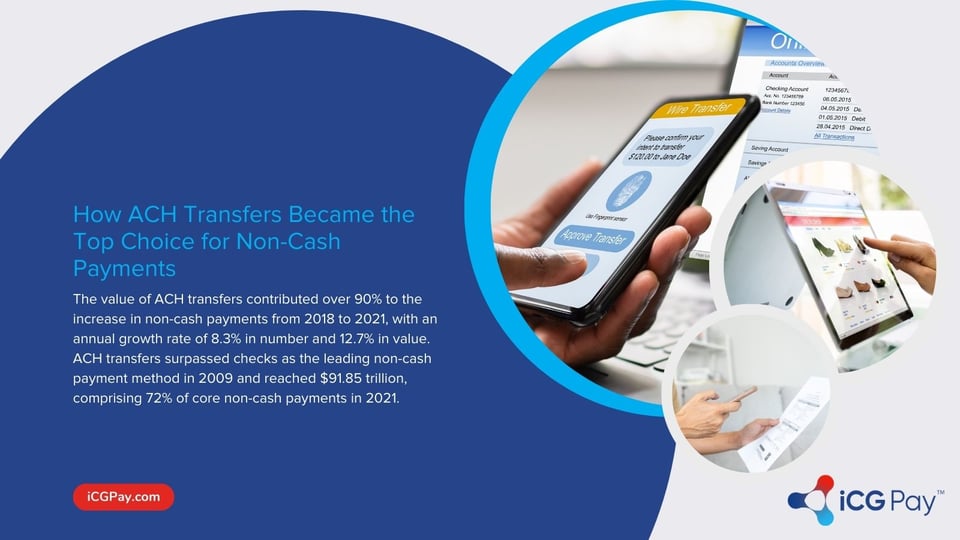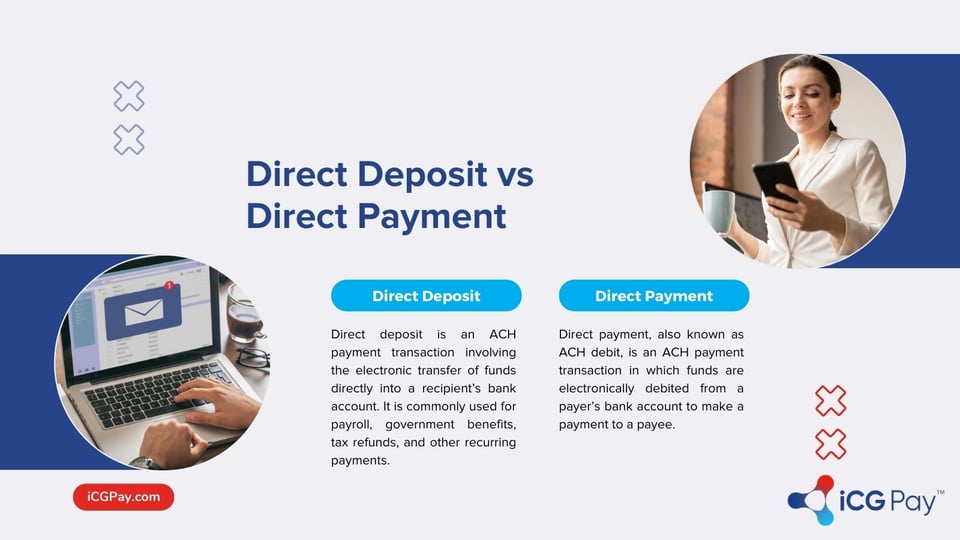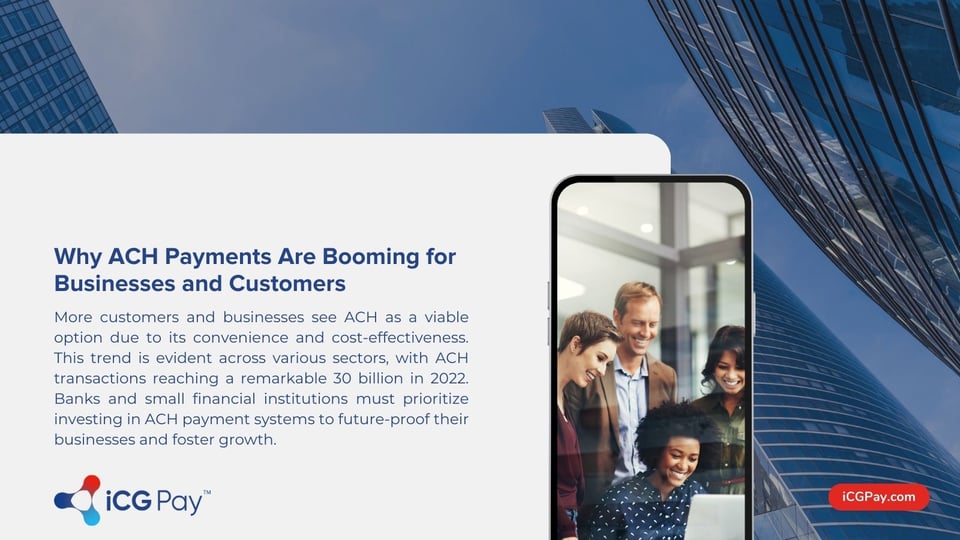The ACH Network kicked off 2023 with impressive growth in the first quarter, particularly in Same Day ACH, where payment amounts nearly doubled compared to the previous year.
ACH payments have consistently grown in recent years, yet they often don’t receive the attention they deserve. But here’s the secret: enabling ACH payments can be the magic wand that small banks and credit unions have been searching for to boost growth and customer satisfaction.
In this short guide, we will explore the digital realm of ACH payments, its significance in the banking industry, and how small financial institutions can harness its power to boost profitability and growth.
What is ACH Payment Processing?
ACH (Automated Clearing House) payments refer to electronic funds transfers between bank accounts in the United States, including transactions like direct deposits, bill payments, and business-to-business payments.
The value of ACH transfers contributed over 90% to the increase in non-cash payments from 2018 to 2021, with an annual growth rate of 8.3% in number and 12.7% in value. ACH transfers surpassed checks as the leading non-cash payment method in 2009 and reached $91.85 trillion, comprising 72% of core non-cash payments in 2021.

Why Should Small Banks and Credit Unions Pay Attention to ACH Payments?
There may need to be more than the growing trend and numbers to convince you why you should build systems incorporating ACH payments, especially when other cashless payment options are available. Let’s uncover the benefits that await financial institutions willing to embrace this modern payment system.
Streamlined Efficiency
Unlike traditional paper-based methods, ACH payments offer:
- Faster processing times: ACH payments typically settle within 1-2 business days, reducing transaction delays and enhancing cash flow management.
- Lower costs: With reduced manual processing and physical paperwork, ACH payments significantly lower transaction costs compared to checks or wire transfers.
- Increased security: ACH payments utilize secure electronic channels, reducing the risk of fraud and identity theft.
Improved Cash Flow
With timely and automated ACH transfers, small banks and credit unions can anticipate incoming and outgoing funds, contributing to better planning, cash flow management, and decision-making.
Enhancing Customer Experience
Financial institutions can provide customers with a convenient and user-friendly experience, offering the flexibility to make payments from the comfort of their homes or on the go. Nearly 80% of B2B business purchases are influenced by customer experience.
Broad Accessibility
Since ACH payments are accessible to a wide range of businesses and individuals, financial institutions can accommodate businesses of all sizes to leverage this payment method for outgoing and incoming transactions.
As the adoption of ACH payments continues to grow, more businesses and individuals opting for ACH payments can result in more transactions processed through the bank or credit union, potentially generating additional revenue.
ACH Payment Types and Processes
Let’s look at the different types of ACH payments and how they can simplify your financial life:
Direct Deposit
Direct deposit is an ACH payment transaction involving the electronic transfer of funds directly into a recipient’s bank account. It is commonly used for payroll, government benefits, tax refunds, and other recurring payments.
By offering ACH direct deposit, you can provide a reliable and efficient way for employers, government agencies, and other organizations to transfer funds directly to your customers’ accounts. In 2022 alone, the ACH Network transferred more than 8 billion Direct Deposits.
Image: https://www.nacha.org/content/ach-network-volume-and-value-statistics
Direct Payment
Direct payment, also known as ACH debit, is an ACH payment transaction in which funds are electronically debited from a payer’s bank account to make a payment to a payee. Authorized payees can electronically debit funds from their customers’ accounts to cover recurring bills such as mortgage payments, utility bills, insurance premiums, and subscription services.
The payee obtains authorization from the payer to initiate the payment, and the funds are automatically deducted from the payer’s account, simplifying bill management.
Preauthorized Payment
Preauthorized payment is a type of direct payment where the payer provides authorization for recurring payments to be made from their bank account. The payee can initiate transactions on a predetermined schedule without obtaining individual approval for each payment, minimizing the need for customers to remember payment due dates and the risk of late or missed payments. It is commonly used for subscription services, membership dues, and installment payments.
Business-to-Business Payments
ACH transactions also facilitate business-to-business (B2B) payments, including payments made between companies for goods or services, vendor payments, and supplier invoices. B2B ACH payments provide a cost-effective and efficient method for businesses to settle their financial obligations, often resulting in streamlined payment processes and improved cash flow management.

Implementing ACH Payment Solutions
Banks can implement ACH (Automated Clearing House) payment solutions by following these general steps:
1. Understand Rules and Regulations
Familiarize yourself with the rules and regulations governing ACH payments, understanding the guidelines set by the National Automated Clearing House Association (NACHA) and your country's applicable laws and regulations.
2. Identify Your Goals and Analyze Your Infrastructure
Assess your bank’s technology infrastructure to ensure it can support ACH payment processing. Determine if any upgrades or modifications are necessary to enable ACH transaction handling and integration with your existing banking systems.
3. Partner with a Reliable Third-Party Solution Provider
Collaborate with ACH operators or payment processors who can facilitate smooth ACH transactions on your behalf. Establish partnerships with PCI-compliant payment processor service providers, preferably Nacha-preferred partners.
Ensure that the provider has extensive knowledge in your industry, has no hidden costs, and can integrate ACH into your current systems with minimal changes and resources.
4. Implement ACH Payment Processing
Integrate ACH payment functionality into your banking systems with the help of your third-party solution providers. This includes developing or configuring software solutions that allow customers to initiate and receive ACH payments, manage payment schedules, and view transaction details.
Test your system internally before making it public to your customers. Monitor and measure to fix bugs early on and offer your customers a reliable and robust system.
Enhancing Customer Experience with ACH Payments
Incorporating ACH payments into your services opens up new opportunities to optimize the customer experience and exceed their expectations. This is how:
Recurring Payments
Encourage customers to set up automatic deductions for bills and subscriptions, eliminating the hassle of remembering due dates and reducing the risk of late fees.
One-Time Payments
Educate customers on initiating one-time ACH payments, whether for large purchases or settling bills, to save them time and effort.
Same-Day ACH Transactions
Inform customers about same-day ACH payment processing that allows funds to be transferred within the same business day for time-sensitive payments or faster access to funds.
But there is more you can do to make the transition seamless for your customers:
- Educating customers about ACH payments.
- Train customer service representatives to address ACH-related inquiries and guide customers through any challenges they may face.
- Highlight the security measures of ACH transactions and educate customers about fraud prevention practices.
Case Studies: Successful Implementations of ACH Payments
Zions Bank, based in Utah, revolutionized its treasury management services by implementing ACH payments to empower businesses, streamline payments, cut costs, and optimize cash flow. As a result, Zions Bank attracted and retained satisfied business clients, solidifying loyalty.
PNC Bank, a prominent US bank, embraced ACH payments to enhance customer convenience and security.
Kay Osmanski, group manager with PNC Bank treasury management, says: “The Electronic Payments Network has always had an impressive record for reliability with 100% uptime, which will serve our customers well.”
By integrating ACH capabilities into its digital banking platform, PNC Bank allowed customers to initiate transfers effortlessly, make bill payments, and manage finances. This forward-thinking approach positioned PNC Bank as a competitive player in the digital banking arena, catering to customer preferences effectively.
Marketing and Promoting ACH Payments
Implementing the ACH payment systems and notifying your customers about it is insufficient in these competing times. You need to invest in marketing to promote your new services to encourage customers to adapt to them:
- Share educational content that explains the concept of ACH payments, how they work, and the steps to set them up. Create blog posts, articles, videos, or infographics that simplify the process and provide tips for using ACH payments effectively.
- Use customer data and transaction history to personalize your communication. Send targeted emails or notifications to customers who frequently make recurring payments and offer personalized recommendations or offers based on their transaction patterns.
- Host workshops or webinars to educate them about the advantages of ACH payments and how to integrate them into their operations.
- Implement referral programs that incentivize existing customers to refer others to use ACH payment services.
Future Trends in ACH Payments
Rest assured, ACH is not just a fad—it’s a permanent fixture. With ongoing advancements in artificial intelligence and continuous development, we can expect even more seamless integration and enhanced efficiency in payment processing, making ACH faster, smoother, and more efficient than ever before.
More customers and businesses see ACH as a viable option due to its convenience and cost-effectiveness. This trend is evident across various sectors, with ACH transactions reaching a remarkable 30 billion in 2022. Banks and small financial institutions must prioritize investing in ACH payment systems to future-proof their businesses and foster growth.
If you’ve any further questions or need expert assistance, don’t hesitate to contact our relationship manager today. We’re here to help you navigate the ACH landscape.






